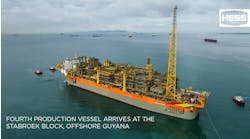The procedures surrounding offshore assurance and verification have altered little since they were established following the North Sea Piper Alpha disaster in 1988. However, the characteristics of the modern oil and gas industry mean there is now a critical need for a change in approach.
Traditionally, assurance and verification have been fully aligned to how the duty holder assures legislative compliance offshore for the identification of major accident hazards, the evaluation of risks and provisions to manage these.
Over the last 30 years, assets have degraded significantly thereby increasing risk, while the originally associated well profiles have reduced in pressures, volatilities and temperatures, leading to a reduction in risk.
In the late life phase, the overall risk profile offshore has fundamentally changed, yet activities related to verification of the management of those risks since initial concept has not. Therefore, it could be argued that they have become prescriptive. This potentially sets a dangerous precedence as it moves away from the “goal setting” intent of the Offshore Installations (Offshore Safety Directive) (Safety Case etc.) Regulations 2015 (SCR).
Invariably, the human element between operator and verifier has led to the verification management process being carried out in silos. This has impacted the ability to ensure overall continued suitability of the verification scheme.
By not having a structured process to assess risks, holistic prioritized recommendations cannot be made to support the implementation of appropriate risk-reducing measures. For an accountable individual such as an operations manager, a clear understanding of what needs to be planned and budgeted for now, and what can be safely mitigated for a later date, is critical.
Examinations of the science and technology behind the way assurance and verification are carried out was undertaken in 2019 by leading verification bureaus and the UK’s Health and Safety Executive. The intention behind these examinations was not only to ensure assurance and verification meet the true intent of the Safety Case legislation through real-time risk verification, but also recognize the value of human intervention to produce tangible results. It was agreed among parties that the effectiveness of verification would be improved if the current focus on plant integrity was extended to give the same degree of emphasis to people and process in line with Step Change guidance recommendations.
At the beginning of 2020, Bureau Veritas introduced a number of pilot projects with operators and industry bodies to define and agree what good assurance and verification practice looks like. The current pilot projects focus on three specific areas: risk-based verification, organizational maturity, and net zero.
The intention of the risk-based verification pilot, which has been accepted in principle by the HSE, is to work in partnership with duty holders to ensure that intervention offshore generates the greatest value by focusing on the areas of highest risk. In turn, areas of low risk are agreed annually with the duty holder so that the advantages of a remote verification scheme can be ensured. Emphasis is placed on the ability of people to make informed decisions based on risk-prioritized quality and timely data to ensure available budgets are used effectively in the most appropriate areas.
The organizational maturity pilot focuses on people and process, acknowledging that human activity can play a key role in many work-based incidents and assisting companies in identifying potential risks and mitigations. It can also provide a quick way for companies to measure organizational efficiency, ensure compliance to safety management systems, and identify key performance indicators to support continuous improvement.
The net zero pilot recognizes the importance of industry-wide initiatives such as carbon trading and offsetting. It may also provide endorsement for duty holder activity to support aspects such as future licensing agreements and new technology funding. Furthermore, where new technologies and energy supplies are being introduced, it may provide an integrated technology qualification to cover an asset’s safety envelope.
The pilots have been well received by operators to date. Work has already begun with one super major on the risk verification and net zero aspects, and a project with another operator will follow shortly.
Working together in this way will ultimately create a standardized basis to industry guidance for all verification schemes to be reviewed against. It will demonstrate what ‘good’ looks like in terms of verification and assurance with the aim of becoming a global benchmark.
However, it is important for anyone who has a contribution to make to join this journey by contacting us, so that together can we all learn to do things better.



